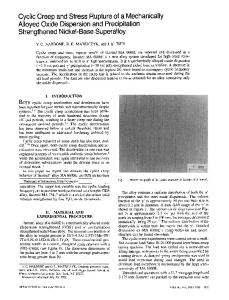Creep and stress rupture of a mechanically alloyed oxide dispersion and precipitation strengthened nickel-base superallo
- PDF / 2,566,744 Bytes
- 8 Pages / 594 x 774 pts Page_size
- 50 Downloads / 353 Views
A
recent advance in the development of high temperature alloys has been the incorporation of inert yttrium oxide dispersoids into a high volume fraction ( ~ 5 0 voI pct) y' precipitation strengthened nickel-base superalloy by the mechanical alloying process. 1The alloy, an experimental alloy made by the International Nickel Company and designated MA 6000E, exhibits both the intermediate temperature strength of a 7' strengthened superalloy and the elevated temperature strength of an oxide dispersion strengthened (ODS) alloy, a combination that makes this superalloy a promising candidate for advanced turbine applications. This study examines the creep and stress rupture behavior of MA 6000E in some detail. Creep testing was carried out over ranges of applied stresses at 760 and 1093 ~ and the apparent stress and temperature dependencies of the steady state creep rate and stress rupture life were determined. While the temperatures chosen for testing represent possible application temperatures, they were also selected in order to observe creep in two temperature regimes: one, (760 ~ where both kinds of strengthening particles should contribute to the creep resistance, and the second temperature (1093 ~ where strengthening is expected from only the inert oxide particles. The results are compared to those of other particle strengthened systems (both ODS alloys and conventional nickel-base superalloys) and are correlated with microscopic and fractographic observations. A recent model that mechanistically describes creep in particle strengthened systems is also used to discuss and rationalize the experimental results. T. E. HOWSON and J. K. TIEN are Research Associate and Professor, respectively, Henry Krumb School of Mines, Columbia University, New York, NY 10027. D. A. MERVYN, formerly at Columbia University, is now with Westinghouse Hanford Company, Richland, WA. Manuscript submitted July 26, 1979.
EXPERIMENTAL PROCEDURE Material Material was provided by NASA-Lewis in the form of 1 cm diam bar. The nominal composition of the alloy in weight percent is 15Cr-4.5AI-2.5Ti-2Mo-4W-2Ta0.5C-0.15Zr-0.1 B- 1.1Y203--balance nickel. After powder processing by mechanical alloying and consolidation by extrusion, the bar was recrystallized to develop a coarse elongated grain structure.t It was subsequently given a three-stage 7' aging heat treatment consisting of 1232 ~ h/Air Cool, then 954 ~ h/Air Cool, and finally, 843 ~ h/Air Cool. The macrostructure of MA 6000E was examined in a Zeiss microscope. All microscopic and fractographic observations were carried out in a JEOLCO transmission electron microscope (Model JEM-100CX) operating in the appropriate transmission or scanning mode. The grain structure, Fig. 1, consists of elongated grains with transverse dimensions of 1 to 2 mm and an average grain aspect ratio greater than 10. Within these large and high aspect ratio grains, a finer grain structure could be resolved in the light microscope. Through selected area diffraction it was found that the grains shared a (110) ___ 20 deg a
Data Loading...











